Furthermore, landfills produce methane -- rather, microbes produce it as they devour anything they can and emit methane as a waste product. Being lighter than air, methane works its way out of the air and into the soils or the atmosphere. Methane has a very high global warming potential (GWP), about 12 times as high as carbon dioxide.
Thursday, April 23, 2009
Landfills : Garbage filled in the lans can pollute the air worse than carbon dioxide
Furthermore, landfills produce methane -- rather, microbes produce it as they devour anything they can and emit methane as a waste product. Being lighter than air, methane works its way out of the air and into the soils or the atmosphere. Methane has a very high global warming potential (GWP), about 12 times as high as carbon dioxide.
Garbage can stay long ...............
- glass bottles require a million years to fully break down in a landfill
- plastic foam cups require over 500 years
- aluminum cans between 200 and 500 years
- plastic bags as many as 20 years, and
- cigarette butts as many as five years.
Wednesday, April 22, 2009
African Buffalo

Large males can weigh over 1,500 pounds and are usually twice the size of females. Males also carry a larger set of horns on top of their head, and have a thicker neck and a shoulder hump. A small fringe of hairs called a dewlap hangs from the throat. Both sexes are dark brown with hair-fringed ears, a hairless muzzle and a long tail.
Love Bird
Sundarban : World's Largest Mangrove Forest


 Image on Google Search :
Image on Google Search :Ice Baby : Mammoth

A near-perfect frozen mammoth resurfaces after 40,000 years, bearing clues to a great vanished species.
For more feature and story Please visit National Geography Features and Photography
Sunday, April 12, 2009
Biologists Discover Thriving Irrawaddy Dolphin Population

© Alice Rocco (via Wildlife Conservation Society)
The Irrawaddy dolphin is listed by the IUCN as vulnerable. But surveys conducted by the Wildlife Conservation Society and Chittagong University in Bangladesh have given biologists hope. The surveys estimate that a population of 6000 live around the coast of Bangladesh – a number far higher than expected.
Still, scientists warn that there are still threats to the dolphins’ survival such as entanglement in fishing nets and changes in water flows due to damming the river.
For more info: New York Times
Cougar

Puma concolor
The cougar, which is also commonly referred to as a puma, mountain lion or panther, is the second largest cat in North America. Unlike other big cats, however, the cougar cannot roar. Instead, the large feline purrs like a house cat.
Cougars also have similar body types to house cats, only on a larger scale. They have slender bodies and round heads with pointed ears. They vary between 1.5-2.7 m (5-9 ft.) from head to tail. While males can weigh up to 68 kg (150 lb.), females weigh less, topping out at nearly 45 kg (100 lb.).
The coat of the cougar is a grayish tan to reddish color with lighter parts on the underside. The tail has a black spot on the end.
Atlantic Puffin

Fratercula arctica
Dubbed "sea parrots" as well as "clowns of the sea," Atlantic puffins sport large, brightly-colored beaks on their substantially-sized heads. Crisp black and white markings on their plumage, as well as superior diving capabilities, have led people to compare the northern seabirds to penguins. However, Atlantic puffins are actually not related to penguins at all. They are in fact small seabirds (about 25 cm, or 10 in., long) that belong to the Alcidae (auk) family.
For most of the year, Atlantic puffins live on the open ocean, with a range spanning from the eastern coast of Canada and the northern United States to the western coast of Europe and northern Russia. 60% of the world's puffins live near Iceland.
Puffins are specially adapted to living on the open sea. Waterproof feathers allow them stay warm as they float at the ocean's surface or swim underwater. Diving as deep as 60 m (200 ft.), they swim by flapping their wings as if flying through the water and use their feet to steer. There, they hunt herring, hake, capelin, and sand eels. They supplement their meals by drinking saltwater.
Friday, March 13, 2009
Thursday, March 12, 2009
Cox's Bazar : Longest Sand beach in the world
Morning in Cox's Bazar Beach
Sunderbans Tiger Project, Part 3
Sundarban Mangroves 2
Sunderbans Tiger Project, Part 1
Tiger kills Crocodile.
sundarbans the honey or the tiger
Tigers in Action : Sunderban
Sundarban : Bangladesh Side
Road to Wonderful Sunderban
Wednesday, March 11, 2009
Terrestrial Impact Craters : Kara-Kul, Tajikistan
Target Name: Earth
Spacecraft: Space Shuttle
Produced by: NASA
Copyright: Copyright Free
Related Documents
* Terrestrial Impact Craters
* Earth From Space
* Frozen Kara-Kul Structure, Tajikistan
Download Options
Name Type Width x Height Size
karakul.jpg JPEG 640 x 423 45K
karakul.jpg JPEG 1516 x 1002 168K
karakul.jpg JPEG 3032 x 2004 854K
Location 38°57'N, 73°24'E
Rim diameter 45 kilometers (28 miles)
Age <10 million years
This picture shows the spectacular Kara-Kul structure. Partly filled by the 25-kilometer (16-mile) diameter Kara-Kul Lake, it is located at 3,900 meters (12,900 feet) above sea level in the Pamir Mountain Range near the Afghan border. Only recently have impact shock features been found in local breccias and cataclastic rocks.
Terrestrial Impact Craters : Gosses Bluff, Northern Territory, Australia
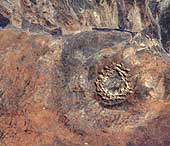 Gosses Bluff, Northern Territory, Australia
Gosses Bluff, Northern Territory, Australia 23°50'S, 132°19'E; rim diameter: 24 kilometers; age: 142.5 +- 0.5 million years 142 million years ago, an asteroid or comet slammed into what is now the Missionary Plains in Australia's Northern Territory, forming a crater 24 kilometers in diameter and 5 kilometers deep. Today, like a bull's eye, the circular ring of hills that defines Gosses Bluff stands as a stark reminder of the event. The crater is located just south of MacDonnel Ranges (top of the picture). It is highly eroded. The circular ring of hills (5 kilometers or 3 miles diameter) is actually the results from differential erosion of the central uplift within this large complex crater. The crater rim is eroded to the point that it is no longer visible though it is probably located along the grayish colored drainage system outside the inner ring. (Courtesy USGS)
23°50'S, 132°19'E; rim diameter: 24 kilometers; age: 142.5 +- 0.5 million years 142 million years ago, an asteroid or comet slammed into what is now the Missionary Plains in Australia's Northern Territory, forming a crater 24 kilometers in diameter and 5 kilometers deep. Today, like a bull's eye, the circular ring of hills that defines Gosses Bluff stands as a stark reminder of the event. The crater is located just south of MacDonnel Ranges (top of the picture). It is highly eroded. The circular ring of hills (5 kilometers or 3 miles diameter) is actually the results from differential erosion of the central uplift within this large complex crater. The crater rim is eroded to the point that it is no longer visible though it is probably located along the grayish colored drainage system outside the inner ring. (Courtesy USGS)Terrestrial Impact Craters : Bosumtwi, Ghana
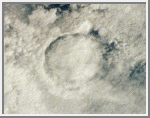 Bosumtwi, Ghana
Bosumtwi, Ghana 06°32'N, 01°25'W; rim diameter: 10.5 kilometers (6.5 miles); age: 1.3 +- 0.2 million years This crater is situated in crystalline bedrocks of the West African Shield and is filled almost entirely by Lake Bosumtwi. Chemical, isotopic, and age studies demonstrate that the crater is the most probable source for the Ivory Coast tektites, which are found on land in the Ivory Coast region of central Africa and as microtektites in nearby ocean sediments. In this photo the crater lake is partly obscured by clouds. (Courtesy NASA/LPI)
06°32'N, 01°25'W; rim diameter: 10.5 kilometers (6.5 miles); age: 1.3 +- 0.2 million years This crater is situated in crystalline bedrocks of the West African Shield and is filled almost entirely by Lake Bosumtwi. Chemical, isotopic, and age studies demonstrate that the crater is the most probable source for the Ivory Coast tektites, which are found on land in the Ivory Coast region of central Africa and as microtektites in nearby ocean sediments. In this photo the crater lake is partly obscured by clouds. (Courtesy NASA/LPI)Terrestrial Impact Craters : Deep Bay, Saskatchewan, Canada
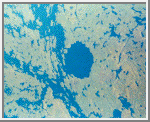 Deep Bay, Saskatchewan, Canada
Deep Bay, Saskatchewan, Canada 56°24'N, 102°59'W; rim diameter: 13 kilometers (8 miles); age: 100 +- 50 million years This crater consists of a near-circular bay, about 5 kilometers (3 miles) wide and 220 meters (720 feet) deep, in the otherwise shallow Reindeer Lake. Such deep circular lakes are unusual in this region, which is dominated by the shallow gouging of glacial erosion. The circular shoreline, at a diameter of 11 kilometers (6.8 miles), is partially surrounded by a ridge with heights to 100 meters (328 feet) above the lake surface. The diameter of this ridge, ~13 kilometers (8 miles), is likely the outer rim of the impact structure. The structure was formed in Precambrian metamorphic crystalline rocks with a conspicuous northwest trending fabric. Although not obvious from the surface, Deep Bay is a complex impact structure with a low, totally submerged central uplift. Samples obtained in the 1960's from drilling into the central structure revealed shocked and fractured metamorphic rocks flanked by deposits of allocthonous, mixed breccias. (Courtesy NASA/LPI)
56°24'N, 102°59'W; rim diameter: 13 kilometers (8 miles); age: 100 +- 50 million years This crater consists of a near-circular bay, about 5 kilometers (3 miles) wide and 220 meters (720 feet) deep, in the otherwise shallow Reindeer Lake. Such deep circular lakes are unusual in this region, which is dominated by the shallow gouging of glacial erosion. The circular shoreline, at a diameter of 11 kilometers (6.8 miles), is partially surrounded by a ridge with heights to 100 meters (328 feet) above the lake surface. The diameter of this ridge, ~13 kilometers (8 miles), is likely the outer rim of the impact structure. The structure was formed in Precambrian metamorphic crystalline rocks with a conspicuous northwest trending fabric. Although not obvious from the surface, Deep Bay is a complex impact structure with a low, totally submerged central uplift. Samples obtained in the 1960's from drilling into the central structure revealed shocked and fractured metamorphic rocks flanked by deposits of allocthonous, mixed breccias. (Courtesy NASA/LPI)Terrestrial Impact Craters : Clearwater Lakes, Quebec, Canada
 Clearwater Lakes, Quebec, Canada
Clearwater Lakes, Quebec, Canada Clearwater Lake West: 56°13'N, 74°30'W; rim diameter: 32 kilometers (20 miles)
Clearwater Lake West: 56°13'N, 74°30'W; rim diameter: 32 kilometers (20 miles) Clearwater Lake East: 56°05'N, 74°07'W; rim diameter: 22 kilometers (13.7 miles)
Clearwater Lake East: 56°05'N, 74°07'W; rim diameter: 22 kilometers (13.7 miles) age: 290 +- 20 million years These twin circular lakes (large dark features) were formed simultaneously by the impact of an asteroidal pair which slammed into the planet approximately 290 million years ago. The lakes are located near the eastern shore of Hudson Bay within the Canadian Shield in a region of generally low relief in northern Quebec province. Notice that the larger western structure contains a ring of islands with a diameter of about 10 kilometers that surrounds the center of the impact zone. They constitute a central uplifted area and are covered with impact melts. The central peak of the smaller Clearwater Lake East is submerged. The lakes are named after their exceedingly clear water. Also notice that the surrounding terrain shows widespread scarring from glaciation. The multitude of linear and irregular shaped lakes (dark features) are the result of gouging or scouring action caused by the continental ice sheets that once moved across this area. (Courtesy NASA)
age: 290 +- 20 million years These twin circular lakes (large dark features) were formed simultaneously by the impact of an asteroidal pair which slammed into the planet approximately 290 million years ago. The lakes are located near the eastern shore of Hudson Bay within the Canadian Shield in a region of generally low relief in northern Quebec province. Notice that the larger western structure contains a ring of islands with a diameter of about 10 kilometers that surrounds the center of the impact zone. They constitute a central uplifted area and are covered with impact melts. The central peak of the smaller Clearwater Lake East is submerged. The lakes are named after their exceedingly clear water. Also notice that the surrounding terrain shows widespread scarring from glaciation. The multitude of linear and irregular shaped lakes (dark features) are the result of gouging or scouring action caused by the continental ice sheets that once moved across this area. (Courtesy NASA)Terrestrial Impact Craters : Manicouagan, Quebec, Canada
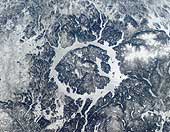 Manicouagan, Quebec, Canada
Manicouagan, Quebec, Canada 51°23'N, 68°42'W; rim diameter: ~100 kilometers (62 miles); age: 212 +- 1 million years The Manicouagan impact structure is one of the largest impact craters still preserved on the surface of the Earth. This shuttle view shows the prominent 70 kilometers (43 miles) diameter, ice-covered annular lake that fills a ring where impact-brecciated rock has been eroded by glaciation. The lake surrounds the more erosion-resistant melt sheet created by impact into metamorphic and igneous rock types. Shock metamorphic effects are abundant in the target rocks of the crater floor. Although the original rim has been removed, the distribution of shock metamorphic effects and morphological comparisons with other impact structures indicates an original rim diameter of approximately 100 kilometers (62 miles). (Courtesy NASA/LPI)
51°23'N, 68°42'W; rim diameter: ~100 kilometers (62 miles); age: 212 +- 1 million years The Manicouagan impact structure is one of the largest impact craters still preserved on the surface of the Earth. This shuttle view shows the prominent 70 kilometers (43 miles) diameter, ice-covered annular lake that fills a ring where impact-brecciated rock has been eroded by glaciation. The lake surrounds the more erosion-resistant melt sheet created by impact into metamorphic and igneous rock types. Shock metamorphic effects are abundant in the target rocks of the crater floor. Although the original rim has been removed, the distribution of shock metamorphic effects and morphological comparisons with other impact structures indicates an original rim diameter of approximately 100 kilometers (62 miles). (Courtesy NASA/LPI) Terrestrial Impact Craters : Mistastin Lake, Newfoundland and Labrador, Canada
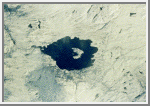 Mistastin Lake, Newfoundland and Labrador, Canada
Mistastin Lake, Newfoundland and Labrador, Canada 55°53'N, 63°18'W; rim diameter: 28 kilometers (17.4 miles); age: 38 +- 4 million years This shuttle image shows a winter view of the Mistastin Crater, a heavily eroded complex structure. Eastward moving glaciers have drastically reduced the surface expression of this structure, removing most of the impact melt sheet and breccias and exposing the crater floor. Glacial erosion has also imparted an eastward elongation to the crater that is particularly evident in the shape of the lake that occupies the central 10 kilometers (6 miles) of the structure. Horseshoe Island, in the center of the lake, is part of the central uplift and contains shocked Precambrian crystalline target rocks. Just beyond the margins of the lake are vestiges of the impact melt sheet that contains evidence of meteoritic features in quartz, feldspar and diaplectic glasses. (Courtesy NASA/LPI)
55°53'N, 63°18'W; rim diameter: 28 kilometers (17.4 miles); age: 38 +- 4 million years This shuttle image shows a winter view of the Mistastin Crater, a heavily eroded complex structure. Eastward moving glaciers have drastically reduced the surface expression of this structure, removing most of the impact melt sheet and breccias and exposing the crater floor. Glacial erosion has also imparted an eastward elongation to the crater that is particularly evident in the shape of the lake that occupies the central 10 kilometers (6 miles) of the structure. Horseshoe Island, in the center of the lake, is part of the central uplift and contains shocked Precambrian crystalline target rocks. Just beyond the margins of the lake are vestiges of the impact melt sheet that contains evidence of meteoritic features in quartz, feldspar and diaplectic glasses. (Courtesy NASA/LPI)Terrestrial Impact Craters : Roter Kamm, South West Africa/Namibia
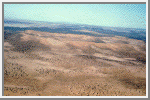 Roter Kamm, South West Africa/Namibia
Roter Kamm, South West Africa/Namibia 27°46'S, 16°18'E; rim diameter: 2.5 kilometers (1.55 miles); age: 5 +- 0.3 million years Located in the Namibia Desert, the raised crater rim is clearly visible against darker background vegetation. Target rocks include primarily Precambrian crystalline rocks and modest amounts of younger sedimentary rocks. Outcrops of impact melt breccias are found exclusively on the crater rim. The crater floor is covered by broad, shifting sand dunes. This image shows an oblique view of the crater, from about 150 meters (492 feet) above ground looking southeast. (Courtesy of W. U. Reimold and LPI)
27°46'S, 16°18'E; rim diameter: 2.5 kilometers (1.55 miles); age: 5 +- 0.3 million years Located in the Namibia Desert, the raised crater rim is clearly visible against darker background vegetation. Target rocks include primarily Precambrian crystalline rocks and modest amounts of younger sedimentary rocks. Outcrops of impact melt breccias are found exclusively on the crater rim. The crater floor is covered by broad, shifting sand dunes. This image shows an oblique view of the crater, from about 150 meters (492 feet) above ground looking southeast. (Courtesy of W. U. Reimold and LPI)Terrestrial Impact Craters : Roter Kamm, SAR-C/X-SAR Image
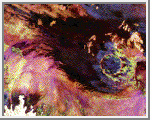 Roter Kamm, SAR-C/X-SAR Image
Roter Kamm, SAR-C/X-SAR ImageTerrestrial Impact Craters : Wolfe Creek, Australia
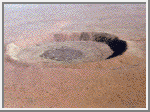 Wolfe Creek, Australia
Wolfe Creek, Australia 19°10' S, 127° 48' E; rim diameter: 0.875 kilometers (.544 miles); age: 300,000 years Wolfe Creek is a relatively well-preserved crater that is partly buried under wind blown sand. The crater is situated in the flat desert plains of north-central Australia. Its crater rim rises ~25 meters (82 feet) above the surrounding plains and the crater floor is ~50 meters (164 feet) below the rim. Oxidized remnants of iron meteoritic material as well as some impact glass have been found a Wolf Creek. This photograph is a south-looking, oblique aerial view of the crater. (Courtesy of V. L. Sharpton, LPI)
19°10' S, 127° 48' E; rim diameter: 0.875 kilometers (.544 miles); age: 300,000 years Wolfe Creek is a relatively well-preserved crater that is partly buried under wind blown sand. The crater is situated in the flat desert plains of north-central Australia. Its crater rim rises ~25 meters (82 feet) above the surrounding plains and the crater floor is ~50 meters (164 feet) below the rim. Oxidized remnants of iron meteoritic material as well as some impact glass have been found a Wolf Creek. This photograph is a south-looking, oblique aerial view of the crater. (Courtesy of V. L. Sharpton, LPI)Terrestrial Impact Craters :Chicxulub, Yucatan Peninsula, Mexico
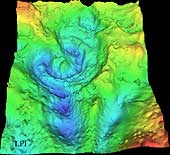 Chicxulub, Yucatan Peninsula, Mexico
Chicxulub, Yucatan Peninsula, Mexico 21°20'N, 89°30'W; diameter: 170 km; age: 64.98 million years This three-dimensional map of local gravity and magnetic field variations shows a multiringed structure called Chicxulub named after a village located near its center. The impact basin is buried by several hundred meters of sediment, hiding it from view. This image shows the basin viewed obliquely from approximately 60° above the surface looking north, with artificial lighting from the south. The image covers 88 to 90.5° west longitude and 19.5 to 22.5° north latitude. NASA scientists believe that an asteroid 10 to 20 kilometers (6 to 12 miles) in diameter produced this impact basin. The asteroid hit a geologically unique, sulfur-rich region of the Yucatan Peninsula and kicked up billions of tons of sulfur and other materials into the atmosphere. Darkness prevailed for about half a year after the collision. This caused global temperatures to plunge near freezing. Half of the species on Earth became extinct including the dinosaurs. (Image courtesy of V. L. Sharpton, LPI)
21°20'N, 89°30'W; diameter: 170 km; age: 64.98 million years This three-dimensional map of local gravity and magnetic field variations shows a multiringed structure called Chicxulub named after a village located near its center. The impact basin is buried by several hundred meters of sediment, hiding it from view. This image shows the basin viewed obliquely from approximately 60° above the surface looking north, with artificial lighting from the south. The image covers 88 to 90.5° west longitude and 19.5 to 22.5° north latitude. NASA scientists believe that an asteroid 10 to 20 kilometers (6 to 12 miles) in diameter produced this impact basin. The asteroid hit a geologically unique, sulfur-rich region of the Yucatan Peninsula and kicked up billions of tons of sulfur and other materials into the atmosphere. Darkness prevailed for about half a year after the collision. This caused global temperatures to plunge near freezing. Half of the species on Earth became extinct including the dinosaurs. (Image courtesy of V. L. Sharpton, LPI)Terrestrial Impact Craters : Barringer Meteor Crater, Arizona
 Barringer Meteor Crater, Arizona
Barringer Meteor Crater, Arizona 35°02'N, 111°01'W; diameter: 1.186 kilometers (.737 miles); age: 49,000 years
35°02'N, 111°01'W; diameter: 1.186 kilometers (.737 miles); age: 49,000 years
The Tyndall Effect and Opalescene of Sky
Opalescence
The Tyndall effect is responsible for some other blue coloration's in nature: such as blue eyes, the opalescence of some gem stones, and the colour in the blue jay's wing. The colours can vary according to the size of the scattering particles. When a fluid is near its critical temperature and pressure, tiny density fluctuations are responsible for a blue coloration known as critical opalescence. People have also copied these natural effects by making ornamental glasses impregnated with particles, to give the glass a blue sheen. But not all blue colouring in nature is caused by scattering. Light under the sea is blue because water absorbs longer wavelength of light through distances over about 20 metres. When viewed from the beach, the sea is also blue because it reflects the sky, of course. Some birds and butterflies get their blue colorations by diffraction effects.
Blue Haze and Blue Moon
Sky in Sunset : Varity of Colour
Why Sky colour is not violet?
Response curves for the three types of cone in the human eye
When we look up at the sky, the red cones respond to the small amount of scattered red light, but also less strongly to orange and yellow wavelengths. The green cones respond to yellow and the more strongly-scattered green and green-blue wavelengths. The blue cones are stimulated by colours near blue wavelengths which are very strongly scattered. If there were no indigo and violet in the spectrum, the sky would appear blue with a slight green tinge. However, the most strongly scattered indigo and violet wavelengths stimulate the red cones slightly as well as the blue, which is why these colours appear blue with an added red tinge. The net effect is that the red and green cones are stimulated about equally by the light from the sky, while the blue is stimulated more strongly. This combination accounts for the pale sky blue colour. It may not be a coincidence that our vision is adjusted to see the sky as a pure hue. We have evolved to fit in with our environment; and the ability to separate natural colours most clearly is probably a survival advantage.
The Sky Colour is blue : Why ?
A clear cloudless day-time sky is blue because molecules in the air scatter blue light from the sun more than they scatter red light. When we look towards the sun at sunset, we see red and orange colours because the blue light has been scattered out and away from the line of sight.
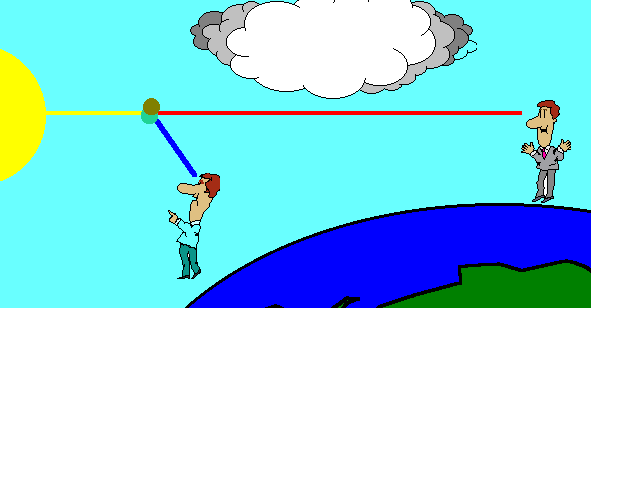
The white light from the sun is a mixture of all colours of the rainbow. This was demonstrated by Isaac Newton, who used a prism to separate the different colours and so form a spectrum. The colours of light are distinguished by their different wavelengths. The visible part of the spectrum ranges from red light with a wavelength of about 720 nm, to violet with a wavelength of about 380 nm, with orange, yellow, green, blue and indigo between. The three different types of colour receptors in the retina of the human eye respond most strongly to red, green and blue wavelengths, giving us our colour vision.
Tyndall Effect
The first steps towards correctly explaining the colour of the sky were taken by John Tyndall in 1859. He discovered that when light passes through a clear fluid holding small particles in suspension, the shorter blue wavelengths are scattered more strongly than the red. This can be demonstrated by shining a beam of white light through a tank of water with a little milk or soap mixed in. From the side, the beam can be seen by the blue light it scatters; but the light seen directly from the end is reddened after it has passed through the tank. The scattered light can also be shown to be polarised using a filter of polarised light, just as the sky appears a deeper blue through polaroid sun glasses.
This is most correctly called the Tyndall effect, but it is more commonly known to physicists as Rayleigh scattering--after Lord Rayleigh, who studied it in more detail a few years later. He showed that the amount of light scattered is inversely proportional to the fourth power of wavelength for sufficiently small particles. It follows that blue light is scattered more than red light by a factor of (700/400)4 ~= 10.
Dust or Molecules?
Tyndall and Rayleigh thought that the blue colour of the sky must be due to small particles of dust and droplets of water vapour in the atmosphere. Even today, people sometimes incorrectly say that this is the case. Later scientists realised that if this were true, there would be more variation of sky colour with humidity or haze conditions than was actually observed, so they supposed correctly that the molecules of oxygen and nitrogen in the air are sufficient to account for the scattering. The case was finally settled by Einstein in 1911, who calculated the detailed formula for the scattering of light from molecules; and this was found to be in agreement with experiment. He was even able to use the calculation as a further verification of Avogadro's number when compared with observation. The molecules are able to scatter light because the electromagnetic field of the light waves induces electric dipole moments in the molecules.
Clouds from Space : Weather System Margin
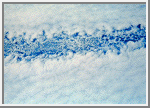 Weather System Margin
Weather System MarginClouds from Space : Eye of Typhoon Yuri
 Eye of Typhoon Yuri
Eye of Typhoon YuriClouds from Space : Vortex Street Near Madeira Island
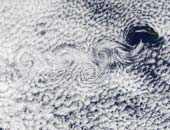 Vortex Street Near Madeira Island
Vortex Street Near Madeira IslandClouds from Space : Typhoon Odessa
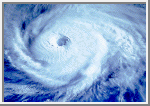 Typhoon Odessa
Typhoon OdessaClouds from Space : Eye of Hurricane Kamysi
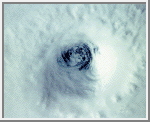 Eye of Hurricane Kamysi
Eye of Hurricane KamysiClouds from Space : Anticyclonic Clouds
 Anticyclonic Clouds
Anticyclonic CloudsClouds from Space : Open Cells Over The Ocean
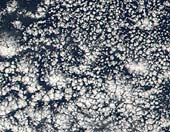 Open Cells Over The Ocean
Open Cells Over The OceanThis image shows open cell cloud formation over the Atlantic Ocean off the southeast coast of the United States. This particular formation is the result of a low-pressure system sitting out in the North Atlantic Ocean a few hundred miles east of Massachusetts. Cold air is being drawn down from the north on the western side of the low and the open cell cumulus clouds begin to form as the cold air passes over the warmer Caribbean waters. (Courtesy NASA/GSFC)
Clouds from Space: Cloud Tail, Lake Tana
 Cloud Tail, Lake Tana
Cloud Tail, Lake TanaClouds from Space: Island Wake, Hawaii
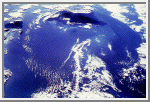 Island Wake, Hawaii
Island Wake, HawaiiClouds from Space: Cloud Streets, Tiladumati Atoll, Maldive Islands
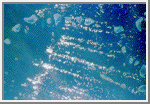 Cloud Streets, Tiladumati Atoll, Maldive Islands
Cloud Streets, Tiladumati Atoll, Maldive IslandsClouds from Space: Jet Stream Convergence
 Jet Stream Convergence
Jet Stream ConvergenceThis photograph taken over Namibia reveals another effect of jet streams. Here two streams converge; cloud has formed in the corridor between the two streams. Turbulence along the margins of the jet stream may explain the sharp boundary. The point of convergence of the two air streams is precisely located by this photograph. Shadows mark the cloud edges against a sunlit Namibian backdrop. (Courtesy LPI/NASA. Picture #13-31-092)
Clouds from Space: Jet Stream Cirrus, Saudi Arabia
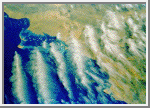 Jet Stream Cirrus, Saudi Arabia
Jet Stream Cirrus, Saudi ArabiaClouds from Space: Unique Cloud Lanes, Oman
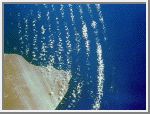 Unique Cloud Lanes, Oman
Unique Cloud Lanes, OmanClouds from Space: Coastal Current, Namibia
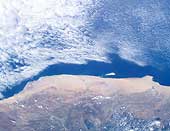 Coastal Current, Namibia
Coastal Current, NamibiaClouds from Space: Cloud Margin, Bering Sea
 Cloud Margin, Bering Sea
Cloud Margin, Bering SeaClouds from Space: Cumulus Cloud Tops
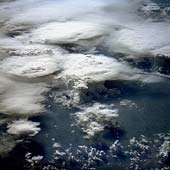 Cumulus Cloud Tops
Cumulus Cloud TopsClouds from Space: Thunderstorms, Brazil
 Thunderstorms, Brazil
Thunderstorms, BrazilClouds from Space: Florida Squall Line
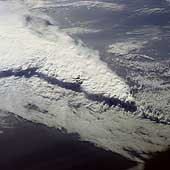 Florida Squall Line
Florida Squall Line